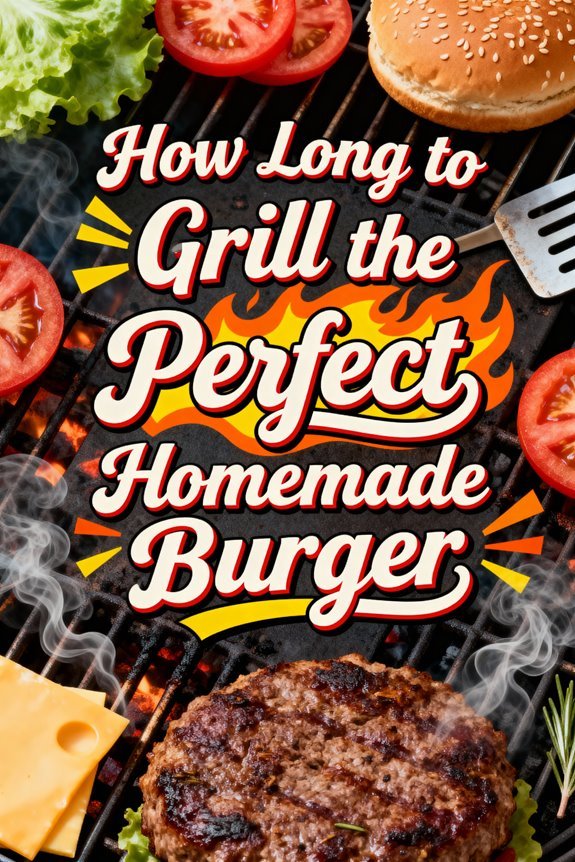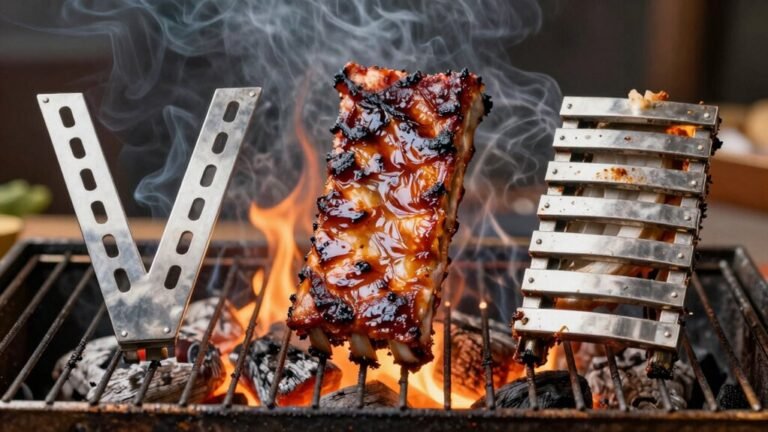To grill the perfect filet tenderloin, start by removing the silverskin and tying the meat with butcher’s twine every 1-2 inches. Season with kosher salt and black pepper, then let it rest at room temperature for 30 minutes. Create three distinct heat zones on your grill, with high heat at 450-500°F for searing. Sear for 2-3 minutes per side, then move to indirect heat until internal temperature reaches 130-135°F for medium-rare. Let rest 5-20 minutes before serving. Master these fundamentals to unleash the full potential of this premium cut.
What Makes Filet Tenderloin Special
While many cuts of beef offer distinct qualities, the filet tenderloin stands out due to its unique anatomical location and muscle structure. Its culinary origins trace to the cylindrical muscle along the spine beneath the ribs, where minimal physical activity creates exceptionally tender meat with fine, densely packed fibers. This premium cut benefits from reverse sear cooking, which helps preserve its delicate texture while developing a flavorful crust. Achieving restaurant-quality results requires a careful two-zone grilling approach for optimal doneness.
You’ll find the filet’s distinctive characteristics stem from its anatomical position. The lack of muscle use results in minimal connective tissue, allowing you to cut it easily with a fork. The flavor notes are delicate and buttery, though less intense than heavily marbled cuts. Considered the king of steaks, this premium cut commands some of the highest prices in the market. Despite its lean profile, the fine marbling present guarantees consistent juiciness. When you’re seeking the most tender beef experience, this premium cut delivers unmatched texture while providing a refined, subtle taste that’s ideal for various preparations.
Essential Tools and Equipment
Success in grilling filet tenderloin depends heavily on having the right tools at your disposal. You’ll need essential accessories starting with a reliable gas or charcoal grill featuring distinct heat zones, along with high-quality tongs and spatula for precise meat handling. An instant-read thermometer is vital for monitoring internal temperatures between 125-135°F for medium-rare results.
For grill maintenance tips, keep a stiff-bristled brush and scraper nearby to clean grates before and after use. vinegar-baking soda soaks help remove stubborn grime buildup from grates. Keeping your grill’s ash catcher clean is crucial for maintaining proper airflow and temperature control. Don’t forget safety equipment like heat-resistant gloves and a fire extinguisher. Your serving arsenal should include a sturdy cutting board, sharp carving knife, and resting rack to guarantee proper moisture retention. Store these tools in a dedicated space to protect them from weather and maintain their condition.
Preparing Your Filet for the Grill
Before firing up your grill, proper preparation of the filet tenderloin guarantees ideal results and flavor development. Begin with meat selection, choosing a center-cut filet with deep red coloring and moderate marbling. For safety precautions, make sure you’re working with fresh meat showing no gray discoloration. Similar to smoking ribs, maintaining consistent temperature control is essential for achieving perfect doneness. Using a high-heat thermometer ensures your grill reaches the optimal 500-600°F range for proper searing.
Remove all silverskin and visible connective tissue, then tie the tenderloin every 1-2 inches with butcher’s twine to maintain uniform shape. Apply your seasoning mix of kosher salt, black pepper, and granulated garlic, incorporating a touch of baking soda to enhance browning. Using a skewer, create small holes throughout the meat to help seasonings penetrate deeper. Drizzle with olive oil, then let the meat rest at room temperature for 20-30 minutes on a wire rack. You’ll want the internal temperature to rise slightly before grilling, making certain of even cooking from edge to center.
Mastering Grill Temperature Control
To achieve professional-level results with your beef tenderloin, mastering temperature control across distinct grilling zones is essential. Since whole tenderloins typically weigh 4-6 pounds, proper zone management becomes crucial. Start by establishing three key zones: low (225-275°F), medium (350-375°F), and high (450-500°F). Proper grill maintenance and temperature calibration guarantee these zones remain consistent throughout cooking. Modern pellet grills excel at maintaining precise temperatures even in cold conditions.
While lower temperatures can work, optimal flavor development requires grilling at 450-500°F for the best sear. Begin with a high-heat sear for 2-3 minutes per side, then shift to medium indirect heat to reach your target internal temperature. For medium-rare, aim for 130-135°F, removing the meat slightly before to account for carryover cooking. Use wireless probes or digital thermometers for precise monitoring, and verify readings regularly with a calibrated instant-read thermometer. Remember to rest your tenderloin for 5-20 minutes after cooking, allowing the temperature to stabilize and juices to redistribute throughout the meat.
Step-by-Step Grilling Process
Mastering the perfect grilled beef tenderloin requires four distinct phases: preparation, searing, indirect cooking, and resting. Begin by trimming excess fat and silver skin, then secure the meat’s shape with butcher’s twine at 2-inch intervals. You’ll need to let your tenderloin marinade at room temperature for 30-60 minutes before applying salt, pepper, and oil. Using high-quality hardwood pellets will infuse your tenderloin with delicious smoky flavors. Similar to internal temperature monitoring in smoked salmon, precision is crucial for achieving the ideal doneness.
Your grilling techniques start with searing at 400-500°F for 4-6 minutes per side, keeping the lid closed to maintain consistent heat. Then, shift to indirect heat, rotating the meat every 15 minutes until reaching your target internal temperature (130-135°F for medium-rare). Monitor progress with a meat thermometer to guarantee precision. Garlic herb butter can be added during the final minutes of cooking to enhance flavor and moisture.
Finally, tent the tenderloin loosely with foil and rest for 5-10 minutes before slicing to maximize juiciness and flavor distribution.
Understanding Doneness Levels
While achieving your desired doneness level requires precision, understanding the temperature ranges and visual cues for each stage is essential for grilling the perfect beef tenderloin. You’ll need to monitor internal temperature closely, as each doneness level spans just 10°F. For rare, aim for 120-130°F with a cool red center, while medium-rare requires 130-140°F, offering a warm red interior. Medium doneness at 140-150°F meets USDA safety guidelines while maintaining good moisture. Medium-well reaches 150-155°F, and well-done exceeds 160°F. The touch test method can serve as a helpful backup when touch testing the meat’s doneness. High heat grilling at 500°F ensures proper searing and caramelization of the exterior.
Remember that carryover cooking will raise the temperature 3-5°F during resting. Room temperature preparation allows for more even cooking throughout the meat. Don’t rely solely on visual doneness indicators – always verify with an instant-read thermometer inserted into the thickest part of your filet for accurate results.
[affiai keyword=”instant read meat thermometer digital” template=”carousel” count=”3″
The Art of Resting and Serving
Proper resting is critical for achieving steakhouse-quality results with your grilled beef tenderloin. After removing your filet from the grill, let it rest for 5-20 minutes in a warm, draft-free area. Cover it loosely with foil to maintain temperature while the meat’s internal heat redistributes. During this time, you’ll notice the temperature rise about 5°F due to carryover cooking. Since this cut is known as filet mignon when portioned, you’ll achieve elegant steakhouse presentation with individual servings.
For serving suggestions, slice your rested tenderloin against the grain into portions appropriate for your guests. Present on warmed plates and consider adding complementary sauces or garnishes for visual appeal. Just as with burgers, maintaining proper heat levels ensures consistent, flavorful results throughout the cooking process. Using an instant-read thermometer is essential for achieving precise temperature control and perfect doneness. You’ll want to time your side dishes to be ready just as the resting period concludes. Remember to monitor the internal temperature with a meat thermometer to guarantee both food safety and your desired level of doneness.
Sauces and Flavor Enhancements
Once your perfectly grilled and rested tenderloin is ready, you’ll want to contemplate the right sauce or flavor enhancement to elevate its natural qualities. Classic sauce pairings include herb-garlic compound butters that melt luxuriously over the hot steak, or cream-based reductions incorporating shallots, wine, and tarragon for sophisticated flavor profiles. Remember to let it rest for 10-15 minutes after grilling before adding any sauces.
For a bolder approach, consider chimichurri’s bright, herbaceous notes to cut through richness, or wrap your filet in bacon before grilling to infuse smoky depth while basting the lean meat. High smoke point oils are essential when searing to achieve that perfect caramelized crust. Some chefs recommend using yellow mustard as a binding agent to help seasonings adhere better to the meat’s surface. You can also apply dry rubs or light marinades, though use these judiciously to preserve the tenderloin’s subtle character. Whatever enhancement you choose, remember that filet mignon’s delicate taste requires balanced accompaniments that complement rather than overwhelm.
[affiai keyword=”steak sauce and seasoning sets” template=”carousel” count=”3″










